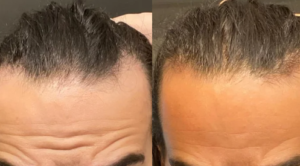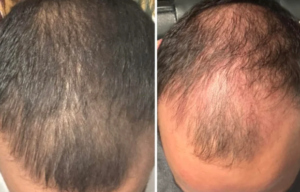I have had well over 1000 patients on finasteride for more than 20 years. It holds onto their hair. I know that because a small handful of these men stopped finasteride, and within three months, they lost significant amounts of hair. Before stopping the drug, they had no further hair loss.
Just 2 months, I noticed I developed mild gynomastia, and am now trying to figure out how to reverse any damage without the need for surgery. I stopped a week ago, and already feel better. I will never touch this drug ever again. If you’re willing to commit to taking pills every day for the rest of your life, just get a hair system.
You did the right thing stopping finasteride. Concealers, other medications like oral minoxidil and even a hair transplant are other great options.
I have been taking 1mg finasteride tablets for the past couple years. I recently experimented with breaking the tablets in half (I have the white octagonal tablets), and my side effects went away. However, my hair also began falling out after 2 weeks. Does breaking the tablets in half affect how they are absorbed? I am not sure if these tablets have coating or not (it’s hard to tell, unlike the red tablets, which appear to be coated), but if they do, does the coating help the drug get absorbed in a more effective manner? Is it possible that by breaking up the tablet and exposing its internal non-coated portion, some of it is going to waste and I am not getting the full .5mg? If there is no absorption issue, is there any risk pertaining to the tablet contents not being dispersed evenly throughout the volume of the tablet?
If you reduce your dose from 1mg to 0.25 mgs, that will reduce the effectiveness of finasteride and could cause hair loss, as in your case. Cutting the pills frequently is the way to go, so that cut pills are kept in an air tight sealed container and only done for a few day supply. Never cut in advance for a month, for example.
I transplanted two best friends a few years ago. This is the ideal hairline for each man. Note that their hairlines are shaped differently. That is because the hairline was negotiated with each man to meet their particular idea of what they wanted to look like. Both hairlines were appropriate, as I never agree to an abnormal hairline. Notice that the hairlines are not straight lines. That is because I always create a transition zone between forehead and the grafts that have more hairs per graft. I use about 400 single hair grafts in the leading edge of the hairline.
The only instrument I am comfortable with is the Dr. Pen device. It oscillates rapidly and I advise people who use it to (1) get the one with the most needles – i.e. 36 needles, (2) go to a depth of no more than 1.25 mm, (2) hold it in each position for 10 seconds. The goal is to produce a wound that goes below the epidermis to the top of the hair follicles, where there are stem cells that this process can stimulate. Once a week is adequate. I would expect bleeding when held for 10 seconds.
I’m on 0.5mg Dutasteride and 5 mg oral minoxidil right now, I’m willing to fight till death to keep my hair but i see a thinning pattern that is scary like nw7 scary. What could I do to more, I’m willing to do anything except sex altering drugs.
You need a good doctor to develop a Personalize Master Plan for your future management of your hair loss. I also always determine the lifetime donor supply, first and foremost. I get a good examination and history from them. I had several men who were heading to a full Class 7 pattern but wanted to keep their hair. That was their priority, and we worked it out. Here is one example of a man that let me show his present results:https://baldingblog.com/norwood-class-7-pattern-patient-received-11000-grafts-plus-smp/
This patient started his journey in 1996, so my command of the Master Plan was not as clear as it is today. If I had not started transplanting his hair loss along his journey, he have progressed to a full Class 7 pattern. I had to keep up with his hair loss which was actively changing by the years. Today, I would have accomplished these results with less than 11,000 grafts, possibly half that number. This man was very particular and demanding, and hair was as important as wealth to him.
Going to test this out – currently on oral min (just started) topical once a day and oral fin. I have a .5 derma roller in my cart but thinking that isn’t enough. I am nervous that a 1 will be too much for someone new to this but also want the best results. Any insight is greatly appreciated!
Microneedling is better than the dermaroller because you deliver a controlled injury, which will be therapeutic if you do it the proper way. The injury should be 10 seconds in each area and repeated every 7 days. I recommend the Dr. Pen device with 36 needles and 1.25mm depth. The body reacts with a healing cascade, which starts with bleeding, platelet aggregation, macrophage infiltration, new blood vessel formation, and stem cell growth, which stimulates the hair cells to regenerate.
https://www.researchgate.net/publication/375039349_Mechanical_stimulation_of_human_hair_follicle_outer_root_sheath_cultures_activates_adjacent_sensory_neurons
The article contains considerable science suggesting that stimulating hair follicles with massage may stimulate hair growth. Great care must be taken to avoid pulling on the hairs during massage, as the miniaturized hairs are easily pulled out.
If you get results and you want to keep the results, then you must stay on the minoxidil for as long as you want to keep the results.
I have a health condition. My doctor advised against taking oral finastride. So I’m just doing rogain foam (monoxidil) and a cheap $25 1mm deep dermaroller (microneedling). I’m very saddened by my hairloss as I valued and took pride in my looks which I now feel like are all ruined with both weight gain and hair loss.
Don’t take charge of yourself, see a doctor. Unfortunately, most family doctors don’t understand the medical treatment of hair loss. It is clear from your question, that you want guidance. I do free consultations so reach out to me williamrassman33@gmail.com
I have only been on finasteride 2 weeks and I am shedding like my dog. Is this expected?
This means that the finasteride will likely be effective. Now, complete the waiting period and show patience.
I continue to believe that microneedling, when done properly once a week while holding the instrument over each balding area for at least 10 seconds, can produce a remarkable reversal of hair loss, especially when combined with finasteride and minoxidil. For a 41-year-old male, your results are remarkable.
I used minox for 6 month I don’t know why last month I lost many of the hair on the cheek even I am using it continuously they are not coming back even after 25 days
I don’t know why this happened. Why did you want minoxidil, for beard hair or for scalp hair. If it is scalp hair, then it will not make any difference for you. If it is beard hair, then what you are reporting is unusual, especially if you didn’t cut back on your dose.
Page 48 of 1247





